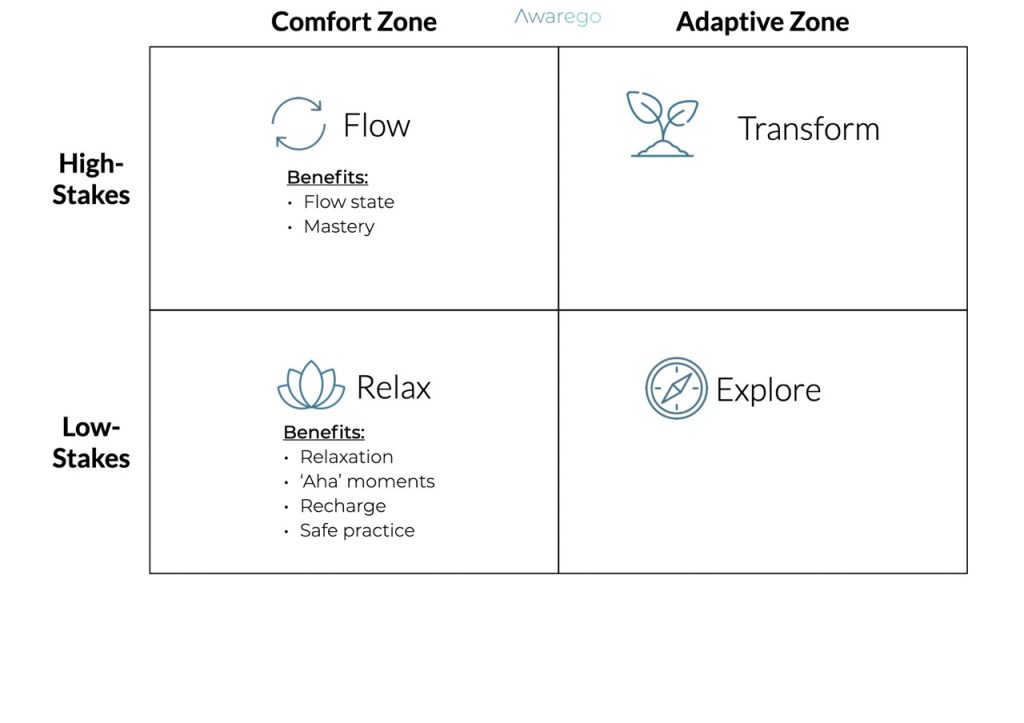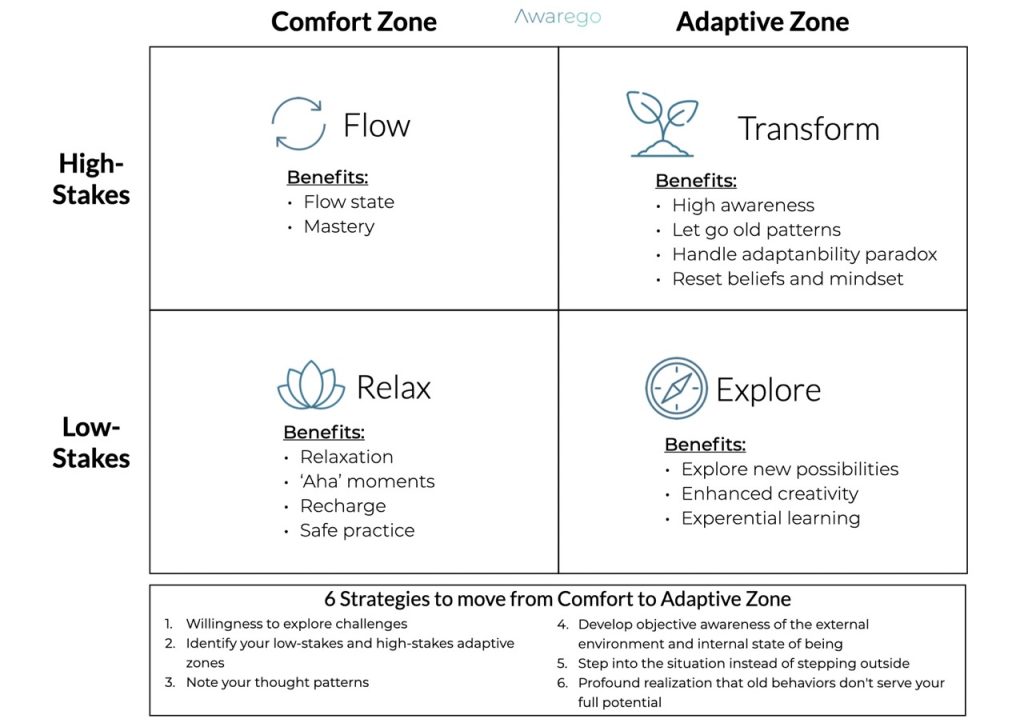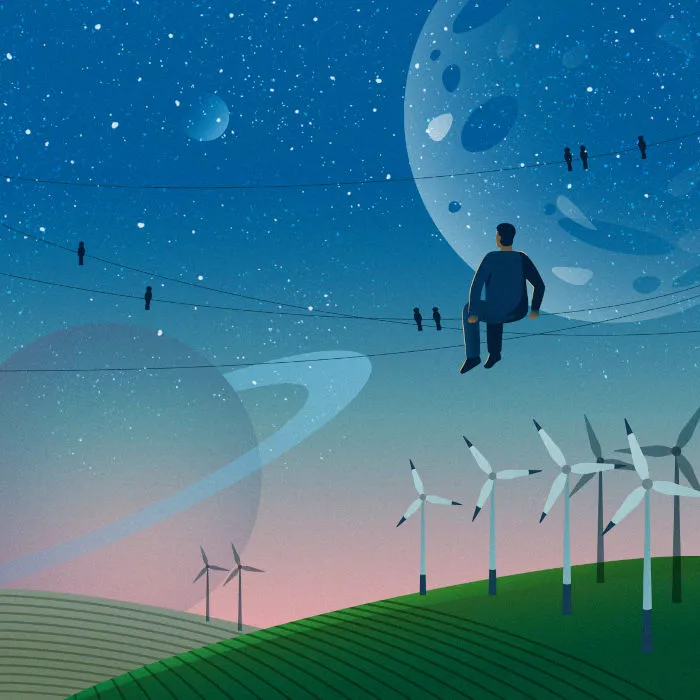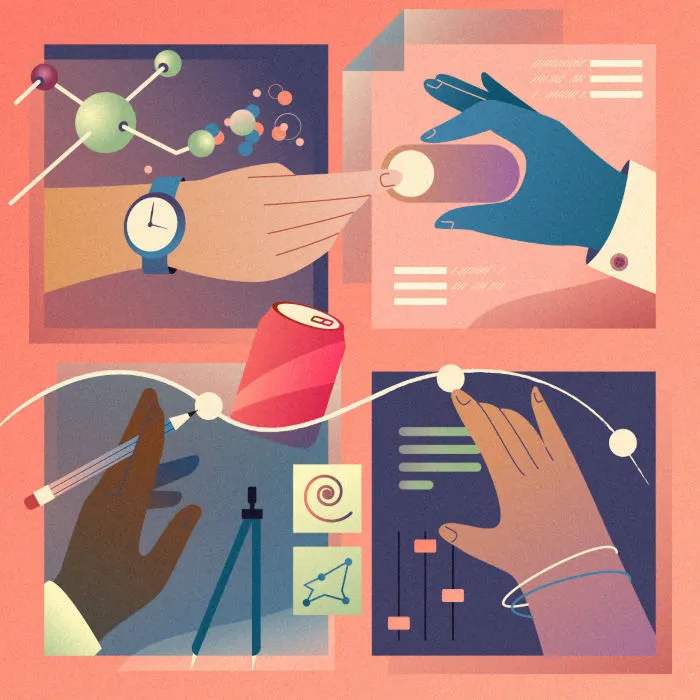
Exiting the Comfort Zone: Six strategies to a Thriving Career and Life
Author: Arthur Lankester
June 29th, 2023
Tools: …
In both our professional and personal lives, we encounter situations demanding navigation through varying contextual zones. Two predominant contextual zones that shape our
experiences are the Comfort Zone, also known as the familiar zone, and the Adaptive Zone.
In the contemporary VUCA world, characterized by volatility, uncertainty, complexity, and
ambiguity, we frequently face unfamiliar challenges within the Adaptive Zone, underscoring the
need to learn effective navigation through this zone.
Two contextual zones that shape our
experience
Comprehension and recognition of each zone are paramount for successful navigation and
flourishing in diverse environments. The Comfort Zone denotes the familiar territory—an
external environment resonating with familiarity and comfort. Successful operation within the
Comfort Zone necessitates specific skills and tools for addressing the tasks and challenges
encountered. Armed with a repertoire of familiar responses, tactics, and behaviors, we are adept
at navigating current situations, directing our efforts confidently toward achieving our intended
goals
Conversely, the Adaptive Zone signifies an external environment posing uncharted territories or
novel challenges. Within this zone, we face unfamiliarity, uncertainty, and unpredictability that
considerably influence our chances of reaching our goals. Upon entering this zone, the
strategies, tactics, and solutions that previously proved beneficial may be inadequate,
necessitating the acquisition of fresh knowledge and skills. Within the Adaptive Zone, we
grapple with the uncertainty of determining actions that yield favorable results and doubts
regarding our ability to overcome the challenge.
Identify the Zone you are in
The objective of vertical development is fostering the ability to identify and navigate the
Adaptive Zone effectively. This entails learning to select the most appropriate response, rather
than reverting to old patterns or becoming overwhelmed by emotional triggers. Awareness
plays a crucial role in recognizing the zone we’re currently in and, more importantly,
understanding what the situation demands from us to achieve our goals.
Absence of this awareness can lead to considerable setbacks as we lean on outdated habits and
patterns insufficient to deal with unfamiliar situations. Conversely, sharpening our ability to
navigate the Adaptive Zone unearths opportunities for exploration, creativity, and deep-seated
personal growth.
The impact of high stakes
When faced with high stakes in a situation, the stress accompanying it can significantly impair
our ability to navigate within the zone effectively. These stakes may manifest objectively, such as
a potentially dangerous traffic situation where our safety is at risk, or subjectively, like the
potential gain or loss of something of deep personal significance. In both instances, the stakes’
intensity can alter our cognitive and emotional state, potentially inducing an ineffective internal
response to the external situation.
In the low-stakes Comfort Zone, we have the liberty to relax and effortlessly hone our existing
skills. This zone offers our mindxs a much-needed respite, fuelling us with enlightening ‘aha’
moments and revitalizing our bodies and mind. It also serves as a safe practice field, allowing us
to learn from mistakes and cultivate resilience.

The benefits of the low-stakes Comfort Zone
(Relax) include:
- Relaxation – providing our mind with a break.
- Experiencing ‘Aha’ moments.
- Recharging our mental and physical energy.
- Offering a safe practice field for routine development.
Relaxation within the low-stakes comfort zone is integral for optimal performance as it
enhances focus, alleviates stress, and nurtures mental clarity. By fostering a serene and stressfree state, you can harness the power to concentrate more effectively, prepare for challenging
tasks, and unleash your creative potential. Embracing relaxation in this context enables you to
present your best self, allowing for easy navigation through challenges and tapping into the
reservoir of your innovative ideas.
Experiencing ‘Aha’ moments may happen during moments of comfort and relaxation, your mind is unburdened by distractions and worries, paving the way for an open and receptive mental state. This clarity and freedom from stress empower you to form new connections,
explore unconventional perspectives, and devise innovative solutions. In this relaxed state, your creativity thrives, opening doors to fresh.
Indulgence in the low-stakes Comfort Zone provides a much-needed recharging for both your mind and body, enabling the replenishment of energy and recovery from life’s challenges. As you surrender to relaxation, activation of your parasympathetic nervous system instigates a state of rest and recovery. This culminates in a reduction in stress hormones, alleviation of muscle tension, and an all-encompassing sense of tranquility and well-being. By consciously incorporating moments of unwinding and recharging, you can effectively replenish your energy reserves, enhance mental clarity, and promote overall physical and emotional well-being.
The low-stakes Comfort Zone also affords a safe practice environment, offering a setting where you can experiment, make mistakes, and learn without significant risks or repercussions. It facilitates the exploration of new skills, techniques, and approaches, thereby stimulating personal growth. Capitalizing on this opportunity helps improve your proficiency, thereby increasing your odds of success when facing more challenging, high-pressure scenarios in the future.
In the high-stakes Comfort Zone, we grapple with demanding challenges that compel us to exert significant effort. Here, we are acquainted with the tools and practices necessary under stressful situations. In high stakes scenarios, we push ourselves to the limit, often reaching what is commonly referred to as “peak performance,” representing an optimal state of functioning and the highest level of achievement and productivity one can attain. We also refer to this state as a state of flow. In this zone, the environment and our abilities to perform within it seem perfectly balanced, making us feel proficient in mastering the necessary skills to effectively tackle challenges.
The benefits of the high-stakes Comfort Zone (Flow) are:
- State of Flow
- Sense of Mastery
The state of flow is a mental condition of complete immersion and focused engagement in an
activity, wherein individuals experience deep enjoyment and optimal performance. In this state, individuals become completely absorbed in the present moment, experiencing a seamless fusion of their actions and consciousness, and losing track of time and self-consciousness.
A sense of mastery is a potent feeling encompassing a profound sense of competence and
confidence, enabling us to navigate specific situations successfully. In this scenario, we can feel
proficient, capable, and empowered, which sparks our motivation to embrace new challenges
and pursue continuous growth. Furthermore, experiencing a sense of mastery significantly
enhances well-being and satisfaction, enriching our overall quality of life.
The limits of the Comfort zone
Despite its name, the Comfort Zone can often be limiting. Staying within the familiar and
comfortable boundaries stifles personal growth and prevents us from realizing our full potential.
Remaining in your Comfort Zone means avoiding risks, trying new experiences, or challenging
oneself. Restricting oneself from embracing new experiences severely curtails your capacity to
learn, adapt, and broaden your skills and knowledge. Stepping outside of your Comfort Zone
opens the door to new opportunities, encourages personal development, and unlocks hidden
talents and capabilities. It is through adventuring into the unknown that you discover your true
potential and experience transformative growth.
The low-stakes Adaptive Zone enables you to discover new situations, stimulate your creativity,
and engage in experiential learning. With low stakes, the potential consequences when things
go awry are not that significant, encouraging you to explore new possibilities and think outside
the box

The benefits of the low-stakes Adaptive Zone (Explore) are:
- Exploration of new possibilities
- Enhanced creativity
- Experiential learning
When fear of failure diminishes, you feel empowered to explore new possibilities beyond the
confines of your Comfort Zone and embrace alternative approaches. This allows you to
accumulate a diverse range of experiences and cultivate skills that exceed traditional forms of
learning. This zone motivates you to embrace the thrill of venturing into uncharted territories,
letting the pursuit of new possibilities shape your
With reduced pressure and fear of failure creativity enhances, as you can feel more comfortable
expressing your ideas, taking risks, and pushing the boundaries of conventional thinking. This
stimulates your creativity and fuels your ability to come up with innovative ideas and practicing
your problem-solving abilities, and encourages fresh perspectives.
This zone stimulates experiential learning because its create a safe space for you to actively
engage in new hands-on experiences, experiment with different approaches, and learn through
practical application. In this zone you are encourages to make mistakes, and reflect on your
experiences, fostering a deeper understanding and mastery of skills.
The high-stakes adaptive zone involves demanding tasks that push individuals to navigate
unique experiences and face real consequences. Here, the pressure to excel can surpass your
typical thinking and behavior, which may not be enough to overcome the challenges. However,
this zone also provides an opportunity to develop new strategies, adapt your approach, and reset
your beliefs and mindset.
The benefits of the high-stakes Adaptive
Zone (Transform) are:
- Heightened state of awareness
- Let go of old patterns
- Handle adaptability paradox
- Reset underlying believes and mindset
High-stakes Adaptive Zone situations leads to a heightened state of awareness. The
unfamiliarity and challenges present in such circumstances demand a sharper focus on both
internal thoughts and external circumstances that may not align. As individuals navigate
through these experiences, they become increasingly attuned to their thoughts, emotions, and
reactions, gaining profound insights into their own mental and emotional landscapes. This
expanded awareness allows for more informed decision-making and the ability to adapt mental
and behavioral responses, fostering personal growth and success in high-stakes scenarios.
This zone helps to let go of old patterns, particularly protective behaviors during stress.
Acknowledging fears and insecurities helps you consciously step out of familiar patterns and
embrace vulnerability. By doing so, new possibilities for behavior emerge, supporting your goals.
The high-stakes adaptive zone confronts the adaptability paradox — which arises from the
notion that the more circumstances demand us to adapt, the more challenging it becomes.. It
triggers a biological inclination to revert to old patterns. However, conscious confrontation of this
response allows for embracing new approaches.
Within this zone, demanding tasks prompt questioning, or reset of existing beliefs. High-stakes
situations compel a growth-oriented mindset, breaking free from limitations. This reset
encourages exploration of new possibilities, unlocking opportunities for growth and success.
Six Strategies to get out of your comfort zone
Navigating through the adaptive zone and freeing yourself from the restrictions of the comfort
zone requires an intentional and strategic approach. By adopting these six strategies, you can
perceive unfamiliar situations with curiosity and view them as invaluable opportunities for
growth and learning:
- Willingness to Explore Challenges: Moving into an uncomfortable environment or situation
demands motivation and discipline. Those who actively seek out experiences beyond their
comfort zone foster a sense of adventure and see challenges as opportunities for growth and
learning. - Identify Your Low-stakes and High-stakes Adaptive Zones: This involves recognizing
situations that test your existing knowledge, skills, and comfort levels. For instance, if public
speaking makes you anxious, presenting in front of a crowd becomes an activity within your
adaptive zone. This requires an understanding of when you are operating within the confines
of your comfort zone and when you have the opportunity to step into a situation representing
the adaptive zone. - Note Your Thought Patterns: Develop self-awareness by paying attention to your thought
patterns. Notice any self-limiting beliefs or negative self-talk that might be holding you back.
Challenge these thoughts and replace them with empowering and positive ones. - Develop Objective Awareness of the External Environment and Internal State of Being:
Stay present and observe your surroundings. Be sensitive to the external factors influencing
your experience. Similarly, tune into your internal state—your emotions, physical sensations,
and thoughts—to better understand how they might be impacting your reactions. - Step into the Situation Instead of Stepping Outside: Embrace discomfort and lean into
challenging situations. Rather than avoiding or withdrawing from them, actively engage and
face them head-on. Embrace the opportunity to stretch yourself and broaden your
capabilities. - Profound realization that old behaviors don’t serve your full potential: Recognize that
clinging to familiar patterns and behaviors may limit your growth. Embrace the profound
realization that stepping outside your comfort zone and adopting new ways of thinking and
acting is essential for realizing your full potential.
By incorporating these strategies into your approach, you can confidently navigate the adaptive
zone and progressively loosen the hold of the comfort zone. Although it may require effort and
resilience, the potential rewards serve as powerful motivation to embark on the journey of selfdiscovery. Embrace the transformative power of stepping into the unknown.

Conclusion: Immediate Action to Step Out of
Your Comfort Zone
Stepping outside of our comfort zone is not merely a choice but a necessity in today’s dynamic and ever-changing world. The dichotomy between the familiar comfort zone and the uncharted adaptive zone shapes our experiences and growth potential. Recognizing the importance of these contextual zones and learning to navigate them effectively is a significant step in personal and professional development.
The comfort zone offers a space for relaxation, recharging, and safe practice. It allows us to hone our skills, experience “aha” moments, and build resilience. However, remaining solely within our comfort zone can inhibit our personal and professional growth. It prevents us from taking risks, trying new experiences, and challenging ourselves.
The adaptive zone presents opportunities for exploration, enhanced creativity, and experiential learning. In this zone, we can embrace new possibilities, think outside the box, and learn through hands-on application. It also provides us a chance to develop new behavioral strategies, adapt our approaches, and reset our underlying beliefs and mindset.
To successfully navigate the adaptive zone, we must be willing to explore challenges, identify our adaptive zones, note our thought patterns, and develop self-awareness. Rather than avoiding discomfort, we must step into challenging situations, recognizing that old behaviors no longer serve our full potential.
By stepping into the unknown, we unlock infinite possibilities for personal and professional growth, tap into our true potential, and experience transformative change.
At Awarego, we help individuals, teams, and organizations act and think. Visit our services page for more information about our training and coaching programs.

MEET THE AUTHOR
Arthur Lankester
Arthur Lankester is a passionate trainer and coach helping individuals and organisations in developing ‘transformational capabilities’. Simply said, Arthur help’s people to develop skills to go through complex personal or organizational changes’. Arthur is graduated (Msc.) Psychologist and Master of Business Administration.
You can count on us!
Discover how you can consciously practice leadership, decision-making and encourage your team to do the same through our trainings. Contact us today so we can customise this e-learning resource to suit your needs.
Add your email to the mailing list to get the latest updates.
Join Our Community
Keep Reading
Stories
- Culture 4
- E-learning 1
- Leadership 4
- Personal development 2
- Transformation 5
- Vertical development 1





